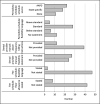State Medicaid Authorities' Policy Communications With Providers on Individualized Pediatric Dental Care
- PMID: 33874788
- PMCID: PMC9109532
- DOI: 10.1177/00333549211008452
State Medicaid Authorities' Policy Communications With Providers on Individualized Pediatric Dental Care
Abstract
Objectives: Medicaid's Early and Periodic Screening, Diagnostic and Treatment (EPSDT) pediatric benefit is designed to meet children's medically necessary needs for care. A 2018 Centers for Medicare & Medicaid Services (CMS) Bulletin advised Medicaid programs to ensure that their dental payment policies and periodicity schedules include language that highlights that medically necessary care should be provided even if that care exceeds typical service frequency or intensity. We assessed the extent to which Medicaid agencies' administrative documents reflect EPSDT's flexibility requirement.
Methods: From August 2018 through July 2019, we retrieved dental provider manuals, periodicity schedules, and fee schedules in all 50 states and the District of Columbia; analyzed these administrative documents for consistency with the CMS advisory; and determined whether instructions were provided on how to bill for services that exceed customary frequencies or intensities.
Results: Dental-specific periodicity schedules were not evident in 11 states. Eighteen states did not include flexibility language, for example, as advocated by the American Academy of Pediatric Dentistry. Flexibility language was not evident in 24 dental provider manuals or in 47 fee schedules. Only 8 states provided billing instructions within fee schedules for more frequent or intensive services.
Conclusion: Updating Medicaid agency administrative documents-including dental provider manuals and periodicity and fee schedules-holds promise to promote individualized dental care as ensured by EPSDT.
Keywords: Medicaid; children; dental care; oral health; pediatric dentistry; preventive health.
Conflict of interest statement
Figures

Similar articles
-
Unraveling EPSDT and Pediatric Hospice Care: An Exploratory Policy Analysis.Am J Hosp Palliat Care. 2022 Dec;39(12):1460-1466. doi: 10.1177/10499091221079329. Epub 2022 Mar 31. Am J Hosp Palliat Care. 2022. PMID: 35357256
-
State Medicaid Early and Periodic Screening, Diagnosis, and Treatment guidelines: adherence to professionally recommended best oral health practices.J Am Dent Assoc. 2013 Mar;144(3):297-305. doi: 10.14219/jada.archive.2013.0117. J Am Dent Assoc. 2013. PMID: 23449906 Free PMC article.
-
From EPSDT to EHBs: the future of pediatric coverage design under government financed health insurance.Pediatrics. 2013 Apr;131 Suppl 2:S142-8. doi: 10.1542/peds.2013-0252e. Pediatrics. 2013. PMID: 23547058
-
Medicaid's EPSDT Benefit: An Opportunity to Improve Pediatric Screening for Social Determinants of Health.Med Care Res Rev. 2021 Apr;78(2):87-102. doi: 10.1177/1077558719874211. Epub 2019 Sep 15. Med Care Res Rev. 2021. PMID: 31524053 Free PMC article. Review.
-
Crossing the Medicaid-private insurance divide: the case of EPSDT.Health Aff (Millwood). 2007 Mar-Apr;26(2):382-93. doi: 10.1377/hlthaff.26.2.382. Health Aff (Millwood). 2007. PMID: 17339664 Review.
References
-
- Centers for Medicare & Medicaid Services . Early and periodic screening, diagnostic, and treatment. Accessed June 24, 2020. https://www.medicaid.gov/medicaid/benefits/early-and-periodic-screening-...
-
- Medicaid and CHIP Payment and Access Commission . EPSDT in Medicaid. Accessed June 24, 2020. https://www.macpac.gov/subtopic/epsdt-in-medicaid
-
- US Department of Health, Education & Welfare, President’s Task Force on Manpower Conservation . One-Third of a Nation: A Report on Young Men Found Unqualified for Military Service. University of Michigan Library; 1964.
Publication types
MeSH terms
LinkOut - more resources
Full Text Sources
Other Literature Sources
Medical

